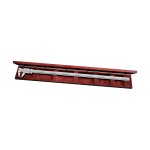elliottandnolan
Member
- Joined
- Dec 15, 2012
- Messages
- 18
I restarted my kitchen-making business about a year ago when I decided that retirement was boring. I was faced with a choice of either buying a sliding table saw (I had the Hammer version before) but decided instead that I would make a full size MFT and make a system for utilising the position information contained within the dog hole spacing.
One of the main differences was the 100mm spacing of the dog holes, this makes it easy to work out where to place the stops for any given width of cut required.
I've put links to the plans, assembly instructions and links to the accessories you would need to make one for yourself on my website at elliottandnolan.com/mft.
I've made a video about it too
I'm starting my YouTube channel from nothing so if you watch it I would appreciate it if you left a comment on the YouTube page
If anyone wants an imperial version (complete with 4" spacing for the dog holes) let me know.
One of the main differences was the 100mm spacing of the dog holes, this makes it easy to work out where to place the stops for any given width of cut required.
I've put links to the plans, assembly instructions and links to the accessories you would need to make one for yourself on my website at elliottandnolan.com/mft.
I've made a video about it too
I'm starting my YouTube channel from nothing so if you watch it I would appreciate it if you left a comment on the YouTube page
If anyone wants an imperial version (complete with 4" spacing for the dog holes) let me know.

